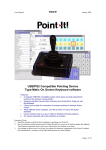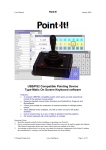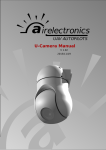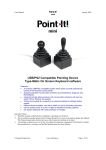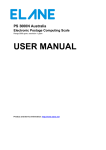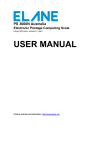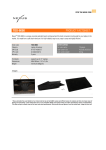Download Research Isometric Transducer 0 to 50 grams and 0 to 500grams
Transcript
Research Isometric Transducer 0 to 50 grams and 0 to 500grams User's Manual Research Isometric Transducer 0 to 50 g and 0 to 500 g, 110 VAC/60 Hz MA1 60-2996 Research Isometric Transducer 0 to 50 g and 0 to 500 g, 220 VAC/50 Hz MA1 60-2999 Publication 5408-001-REV-A WEEE/RoHS Compliance Statement EU Directives WEEE and RoHS To Our Valued Customers: We are committed to being a good corporate citizen. As part of that commitment, we strive to maintain an environmentally conscious manufacturing operation. The European Union (EU) has enacted two Directives, the first on product recycling (Waste Electrical and Electronic Equipment, WEEE) and the second limiting the use of certain substances (Restriction on the use of Hazardous Substances, RoHS). Over time, these Directives will be implemented in the national laws of each EU Member State. Once the final national regulations have been put into place, recycling will be offered for our products which are within the scope of the WEEE Directive. Products falling under the scope of the WEEE Directive available for sale after August 13, 2005 will be identified with a “wheelie bin” symbol. Two Categories of products covered by the WEEE Directive are currently exempt from the RoHS Directive – Category 8, medical devices (with the exception of implanted or infected products) and Category 9, monitoring and control instruments. Most of our products fall into either Category 8 or 9 and are currently exempt from the RoHS Directive. We will continue to monitor the application of the RoHS Directive to its products and will comply with any changes as they apply. • Do Not Dispose Product with Municipal Waste • Special Collection/Disposal Required Table of Contents Harvard Apparatus Research Isometric Transducer User ’s Manual 1 SUBJECT PAGE NO. Warranty and Repair Information ........................2 Theory of Operation ..............................................3 Operation: Transducer Mounting..........................................4 Positioning the Muscle Sample ..........................4 Splash Shield......................................................4 General Information: Amplifier/Power Supply ......................................5 Front Panel Controls: Range Selector Switch ..................................5 Offset ............................................................5 Internal Controls and Adjustments ....................6 Electrical Output ................................................6 Maintenance and Storage ..................................6 Serial Number ....................................................6 Overall Transducer Diagram ................................7 Warranty and Repair Information 2 Harvard Apparatus Research Isometric Transducer User ’s Manual Serial Numbers All inquires concerning our product should refer to the serial number of the unit(s). W a rr a n t y Harvard Apparatus warranties the instrument(s) for a period of two years from date of purchase.At its option, Harvard Apparatus will repair or replace the unit(s) if it is found to be defective as to workmanship or material. This warranty does not extend to damage resulting from misuse, neglect or abuse, normal wear and tear, or accident. This warranty extends only to the original customer purchaser. IN NO EVENT SHALL HARVARD APPARATUS BE LIABLE FOR INCIDENTAL OR CONSEQUENTIAL DAMAGES. Some states do not allow exclusion or limitation of incidental or consequential damages so the above limitation or exclusion may not apply to you. THERE ARE NO IMPLIED WARRANTIES OF MERCHANTABILITY, OR FITNESS FOR A PARTICULAR USE, OR OF ANY OTHER NATURE. Some states do not allow this limitation on an implied warranty, so the above limitation may not apply to you. If a defect arises within the two-year warranty period, promptly contact Harvard Apparatus, Inc. 84 October Hill Road, Holliston, Massachusetts 01746-1371 using our U.S. only toll free number 1-800-272-2775 or dial (508) 893-8999. Goods will not be accepted for return unless an RMA (returned materials authorization) number has been issued by our customer service department.The customer is responsible for shipping charges. Please allow a reasonable period of time for completion of repairs, replacement and return. If the unit is replaced, the replacement unit is covered only for the remainder of the original warranty period dating from the purchase of the original device. This warranty gives you specific rights, and you may also have other rights which vary from state to state. R e p a i r F a c i l i t i e s a n d P a rt s Harvard Apparatus stocks replacement and repair parts. When ordering, please describe parts as completely as possible, preferably using our part numbers. If practical, enclose a sample or drawing.We offer a complete reconditioning service. CAUTION: Not for clinical use on human patients. Theory of Operation Harvard Apparatus Research Isometric Transducer User ’s Manual 3 This transducer operates on the principle of converting picofarad capacitance changes into an amplified DC output voltage by means of a patented circuit (U.S. Patent Number 412144). The transducer consists of a stiff beam suspended between two capacitor plates. This forms a differential capacitor. Using this principal, the beam can be exceptionally stiff, approaching the ideal of measuring force without motion. As an example, for a force of 1 gram, the beam deflection is a maximum of only 10 microns in either the 50 or 500 gram range mode. The linearity is within ±1% with a high DC voltage output and freedom from drift. Operation 4 Harvard Apparatus Research Isometric Transducer User ’s Manual Tr a n s d u c e r M o u n t i n g The transducer comes with an integral short, rigid mounting handle. (See Fig. 1 and 2) To obtain maximum advantage of stiff beam characteristics of the transducer, it should be positioned and held in place with hardware that is as rigid as possible such that all the muscle forces are recorded (i.e. captured) and none are lost in extraneous deflections of the mounting hardware. The 55-0640 Harvard Research Support Stand is the mounting hardware of choice. Its massive, durable construction will not deflect under load. The transducer itself should be positioned such that the output cable at the rear of the transducer ends up on the bottom. (See Fig. 1 and 2) Positioning the Muscle Sample The transducer has a short shaft/rod with a groove that projects from the front. See Figure 1 below. One end of the non-stretching string must be formed into a loop and fastened into the groove on the shaft. The other end of the string is subsequently attached to the muscle preparation. The string must be at right angle to the transducer shaft and be pulled straight downward once the final setup has been completed. Mounting Handle Grooved Shaft 90˚ Splash Shield Non-Stretch String to Muscle Specimen Output Cable Figure 1. Positioning the Muscle Sample Splash Shield The transducer is equipped with a transparent, removable plastic shield which helps to prevent buildup of salts (i.e. corrosives) which may otherwise tend to accumulate on the transducer beam shaft and migrate into the tranducer circuit. (See Fig. 1) In time, this salt buildup can deteriorate performance. The cord/cable/wire from the beam must be directed through the slot in the splash shield without touching the edges. See Figure 1 above. General Information 5 Harvard Apparatus Research Isometric Transducer User ’s Manual Amplifier/Power Supply a) The entire transducer is powered by a 12 volt AC wall transformer. (See Fig. 2) b) There is no ON/OFF switch. The unit can remain powered, as shown on the digital meter, for the entire experiment. F ro n t P a n e l C o n t ro l s A. Range Selector The range selector switch has two positions: 50 gram and 500 gram (See Fig. 2) 1) In the 50 gram position, a 50 gram force produces a 2 VDC output. 2) In the 500 gram position, a 500 gram force produces a 2 VDC output. B. Offset The OFFSET control enables the user to set a zero output voltage for any pre-load value. (See Fig. 2) It is essentially a “Tare Control” device since it balances out static loads such as the weight of the muscle preparation prior to contraction. Mounting Handle Splash Shield Signal Cable Power Supply External Offset Control ISOMETRIC TRANSDUCER VOLTS OUTPUT Range Selector OFFSET 12 Volt AC Wall Transformer 12 Volt AC Cable Figure 2. Diagram of Isometric Transducer General Information 6 Harvard Apparatus Research Isometric Transducer User ’s Manual I n t e r n a l C o n t ro l s a n d A d j u s t m e n t s On the rear panel of the power supply are three small access holes to the trim pots. (See Fig. 3) The high and low gain trim pots are used to adjust the range. The righthand trim pot is factory set to deliver 2.0 VDC for 50 gram. The center trim pot is factory set to deliver 2.0 VDC for 500 gram. Either can be adjusted to deliver more or less output as conditions dictate. The OFFSET adjustment trim pot is located on the extreme left and has been factory adjusted to center the offset control. It also can be adjusted in situations where the front panel offset control does not have sufficient range. It can be used to correct for static loads up to 2.5 grams. Electrical Output a) Binding post are provided on the power supply for output connections. Red is positive (+); black is negative (–) and also ground. (See Fig. 3) b) Output voltage is 0 to 2.0 VDC depending upon the position of the range selector switch. Output impedance is 2 kΩ for direct connection to all recorders. c) The transducer is linear to 100% overload (1000 g = 4 V). Binding Posts High-Gain Trim _ Low-Gain Trim + Offset Trim To Transducer Sensing Head 12 Volt AC input Figure 3. Electrical Output Maintenance and Storage a) No special precautions are required other than preventing corrosive solutions from entering the space where the output shaft exits the transducer. b) When not in use, store in a clean, dry place. Serial Number The serial number is located on the power supply circuit board. Refer to this number in any correspondence. Overall Transducer Diagram Harvard Apparatus Research Isometric Transducer User ’s Manual 7 Grooved Shaft Mounting Handle 90˚ Splash Shield Non-Stretch String to Muscle Specimen Signal Cable Power Supply Signal Cable External Offset Control ISOMETRIC TRANSDUCER VOLTS OUTPUT Range Selector OFFSET 12 Volt AC Wall Transformer 12 Volt AC Cable Binding Posts High-Gain Trim Low-Gain Trim _ + Offset Trim To Transducer Sensing Head Figure 4. Overall Transducer Diagram 12 Volt AC Input











